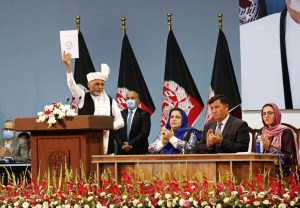The Afghan Loya Jirga (grand assembly) approved the release of 400 Taliban prisoners on Sunday, and President Ashraf Ghani endorsed the decision. This hopefully paves the way for the intra-Afghan talks between Afghan delegates and the Taliban insurgency, aimed at ending the 19 years of war.
“I look forward to the intra-Afghan dialogues,” said Khalid Noor, the youngest member of the Afghan negotiating team. He added, “I believe it’s going to start in the next few days.”
On Monday, the Taliban and the Afghan government agreed on August 16 as the start date for the intra-Afghan dialogues. The 21 members of the Afghan negotiation team headed by Massoum Stanikzai (former chief of the National Directorate of Security) is likely to depart Afghanistan for Doha, Qatar once the prisoners are released — as early as tomorrow.
The 400 prisoners were the last of a group of 5,000 whose release was promised in the U.S.-Taliban peace deal, signed on February 29. The Afghan government was hesitant to release these last prisoners for various reasons, from a lack of presidential constitutional authority to a desire to hold the prisoners responsible for their actions as well as a need for leverage for the Afghan government after the U.S.-Taliban deal.
The release of these high-level prisoners — charged with murder, kidnapping, and abduction — has proved especially problematic, as most previously released prisoners have already been reported to be back on the battlefield against the government. Abdullah Abdullah called this prisoner release a “decision of life and death.”
Therefore, the Loya Jirga was called, with representatives and delegates gathered from 34 provinces of Afghanistan to decide the fate of these prisoners.
It is unknown how events will unfold from here. Will the Taliban keep their promise to reduce violence while engaging in talks with the Afghanistan negotiators? Or will they increase their operations now that these trained commanders have been released?
The U.S.-Taliban agreement mandated the release of 5,000 Taliban prisoners so that intra-Afghan dialogues could start as early as March 10. However, the political chaos that resulted from the disputed September 2019 presidential elections between Ghani and Abdullah paused the peace process. It was only earlier this year that political compromise allowed peace talks to start yet again.
Now, Afghanistan’s future looks promising because its political community, members of civil society organizations, members of the press, and citizens are all eager to start the intra-Afghan talks. Nearly two decades of war with the Taliban have left nothing but scars, sorrow, destruction, and devastation. The world has come to understand that peace talks, a political settlement, and negotiations are the best-applied approach in the case of Afghanistan.
If everything goes as planned, the first step would be a small team of Afghan negotiators meeting with the Taliban political office and preparation team in Doha. A time will then be set for the start of official peace talks.
Talks will focus on key issues, such as the U.S. troop withdrawal and regime change (whether Afghanistan will be an emirate, a republic, or a combination) at the forefront. Also at stake is the fate of the Afghan Constitution, with possible amendments to its law enforcement and legal aspects.
Issues related to the Taliban’s disarmament, demobilization, and reintegration (DDR) and the fate of their 40,000-60,000 fighters will be considered too. Will Taliban fighters join the Afghan forces or other agencies, or they will be placed under some sort of reintegration and deradicalization programs?
Many other issues will be discussed, but these are some of the main areas of clashes and conflict that may take longer for the negotiators to reach a compromise.
Upon a successful peace agreement, there will be a “new government,” as written in the U.S.-Taliban agreement. Afghan leaders see this as a great start for a new Afghanistan free of violence. An interim government will likely be created composed of the Taliban, technocrats of the Afghan government, opposition parties, and prominent Mujahideen leaders. If everything goes as planned, then a presidential, semi-presidential, or a parliamentary election will be held. Many Afghans envision a French style of government — a president and a prime minister with designated authorities.
Afghanistan will flourish and the people will breathe in peace if the leaders compromise, put their differences aside, and work for the national interest and the common good. If the country creates a strong central government that includes the Taliban and broader political parties in Afghanistan, then the fight can continue to eliminate the Islamic State and other 22 terrorist organizations that operate in Afghanistan. This will be one of the longest peace processes, with a bumpy and complex route, but at long last the future is promising.
Ahmad Mohibi is the founder of Rise to Peace, a U.S.-based organization.
































